Places to Watch Seventh Edition: Five Indicated Illegal Logging Area in Indonesia
This article is currently only available in Indonesian.
This seventh edition features the top 5 Places to Watch for indications of illegal logging between 1 July and 30 September 2019.
#1 Indication of Illegal Logging at a 480.96-Ha Area
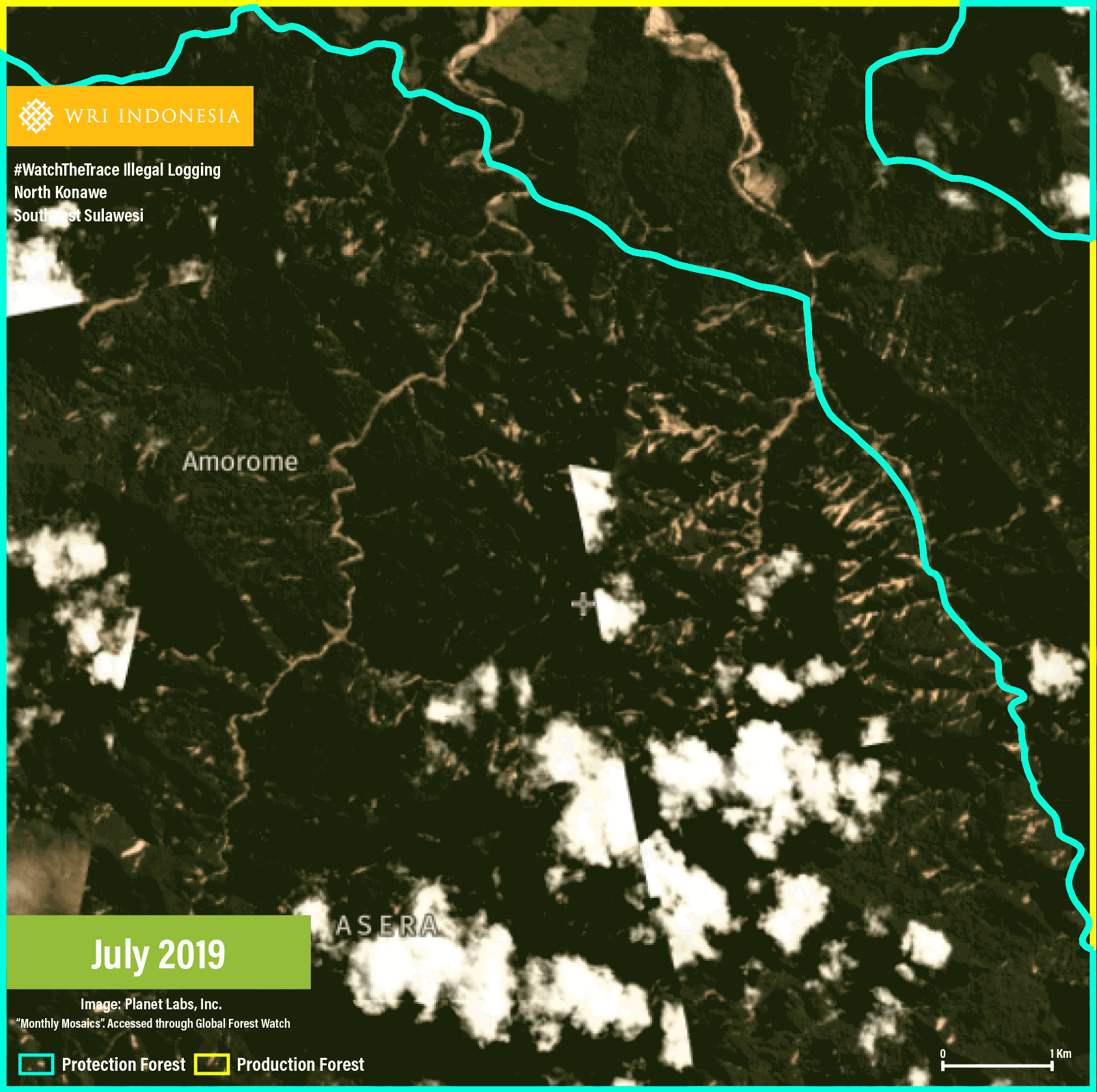
The first (#1) indicated area of 480.96 ha is located in Asemi Nunulai Village, Asera District, North Konawe Regency, Southeast Sulawesi. An indication of illegal logging has been spotted in the protected area of primary dryland forest of Unit XX Protected Forest Management Unit (KPHL) of Central Laiwoi.
Based on observation of high-resolution satellite images of the area, logging activities were allegedly carried out selectively starting from around mid-May to early July 2019. Small logging blocks were seen expanding along the hill and throughout the road that is connected to the river, allegedly providing the access for logging and/or hauling activities.
Illegal loggings in the protected forest area of North Konawe District have been reported since 2017.
#2 Indication of Illegal Logging at a 349.83-Ha area
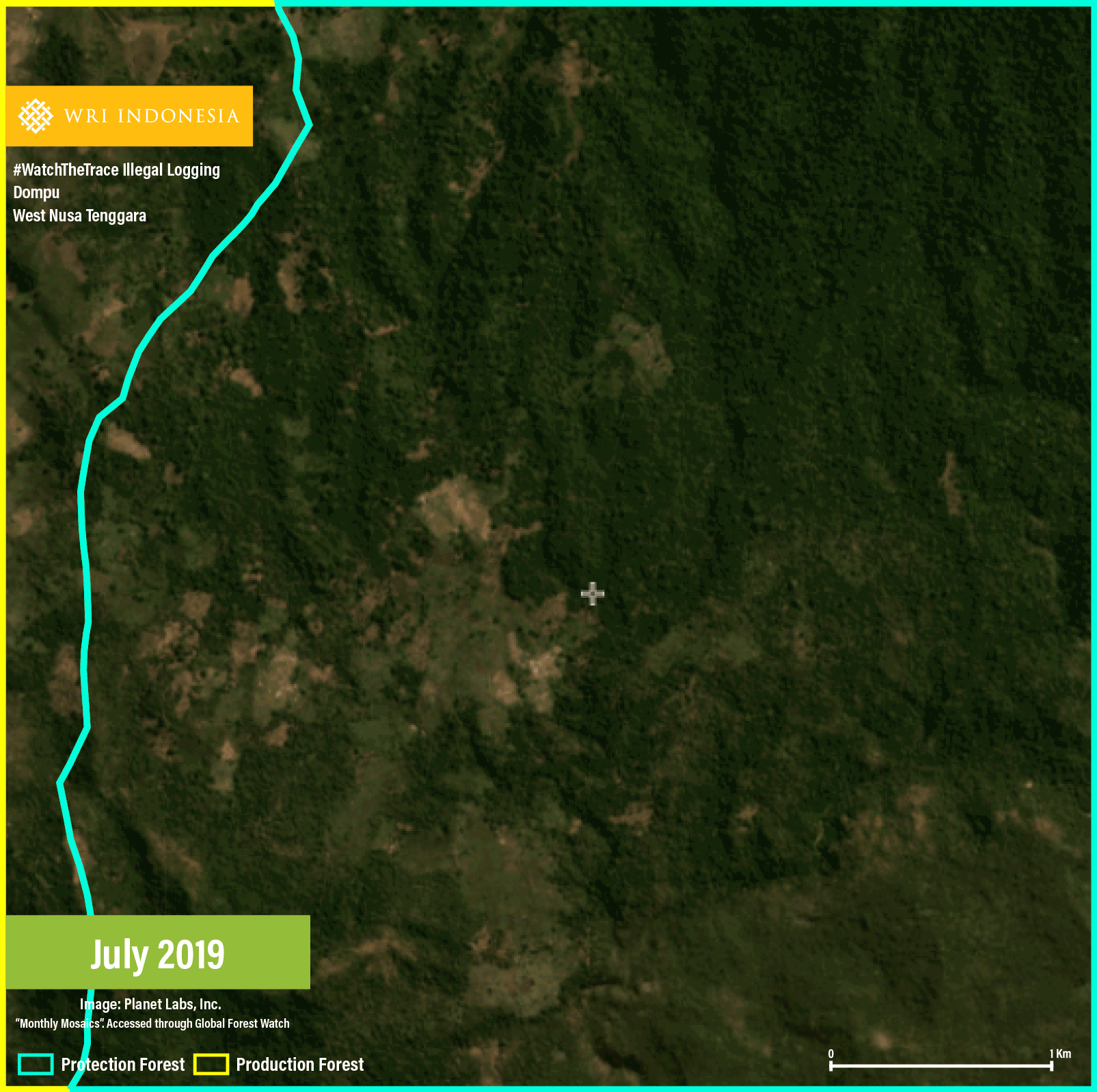
The second (#2) indicated area is located in the Rababaka Village, Woja District, Dompu Regency, West Nusa Tenggara. An indication of logging has been spotted at an area of 349.83 ha that belongs to the protected forest area of Unit XIX KPHL NTB, which is adjacent to a concession area with Business License for the Utilization of Timber Forest Products – Industrial Plantation Forest (IUPHHK-HTI).
High-resolution satellite images indicate that the forest cover loss happened gradually in small blocks and were mostly spotted in the western and southern parts of the indicated area. Signs of burning after logging were also seen in many parts in the indicated area, but the driving factor of the forest cover loss cannot be identified yet because there has been no visible exploitation of the logged-over area.
Reported in April 2019, the Head of the Forest Management Unit of Ampang Riwo Soromandi of West Nusa Tenggara Province explained that the deforestation activities that occurred in his jurisdiction are centered in Dompu Regency. Although the reported location actually differs from our indicated area #2, this suggests that illegal logging remains a chronic issue in Dompu Regency, West Nusa Tenggara.
#3 Indication of Illegal Logging at a 231.21-Ha area
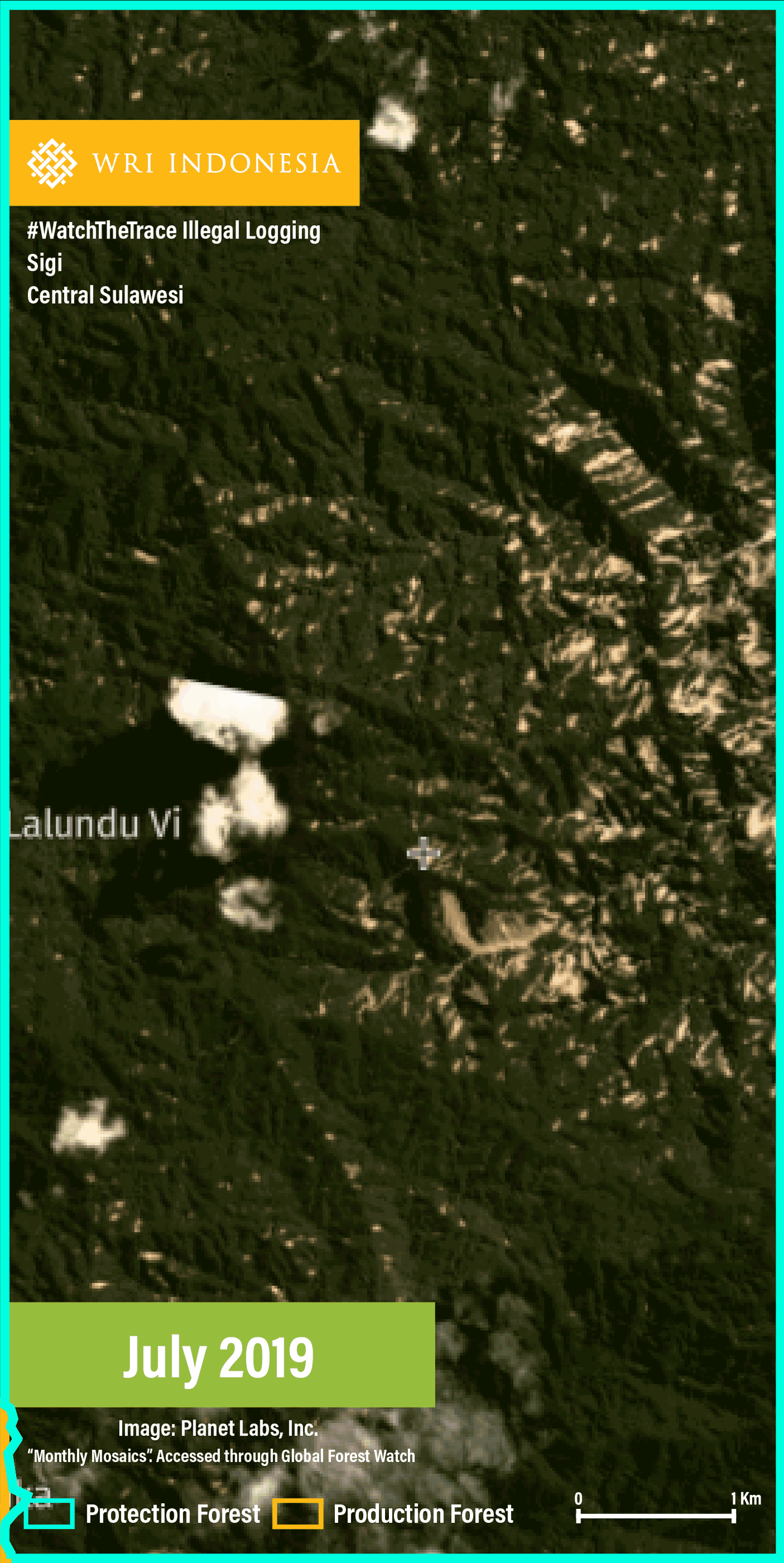
The #3 indicated illegal logging area of 231.21 ha is located in Walatana Village, South Dolo District, Sigi Regency, Central Sulawesi. The area in particular belongs to the protected forest area of Unit VII KPHL Banawa Lalundu and Unit VIII KPHL Kulawi. Logging activities are allegedly carried out selectively in small blocks that expand along the hill. The blocks are connected to a river in the valley, which is allegedly the spot used for logs hauling. Based on observation of high-resolution satellite images of the area, logging activities allegedly have taken place since a year ago and still continue today.
Illegal logging activities in Sigi Regency were believed to be the main cause of flooding in April 2019 that made Walatana Village one of the affected areas. The findings of Walhi’s Central Sulawesi office also confirmed that the flash flood last year was an impact of illegal logging activities around the affected villages.
#4 Indication of Illegal Logging at a 205.38-Ha area
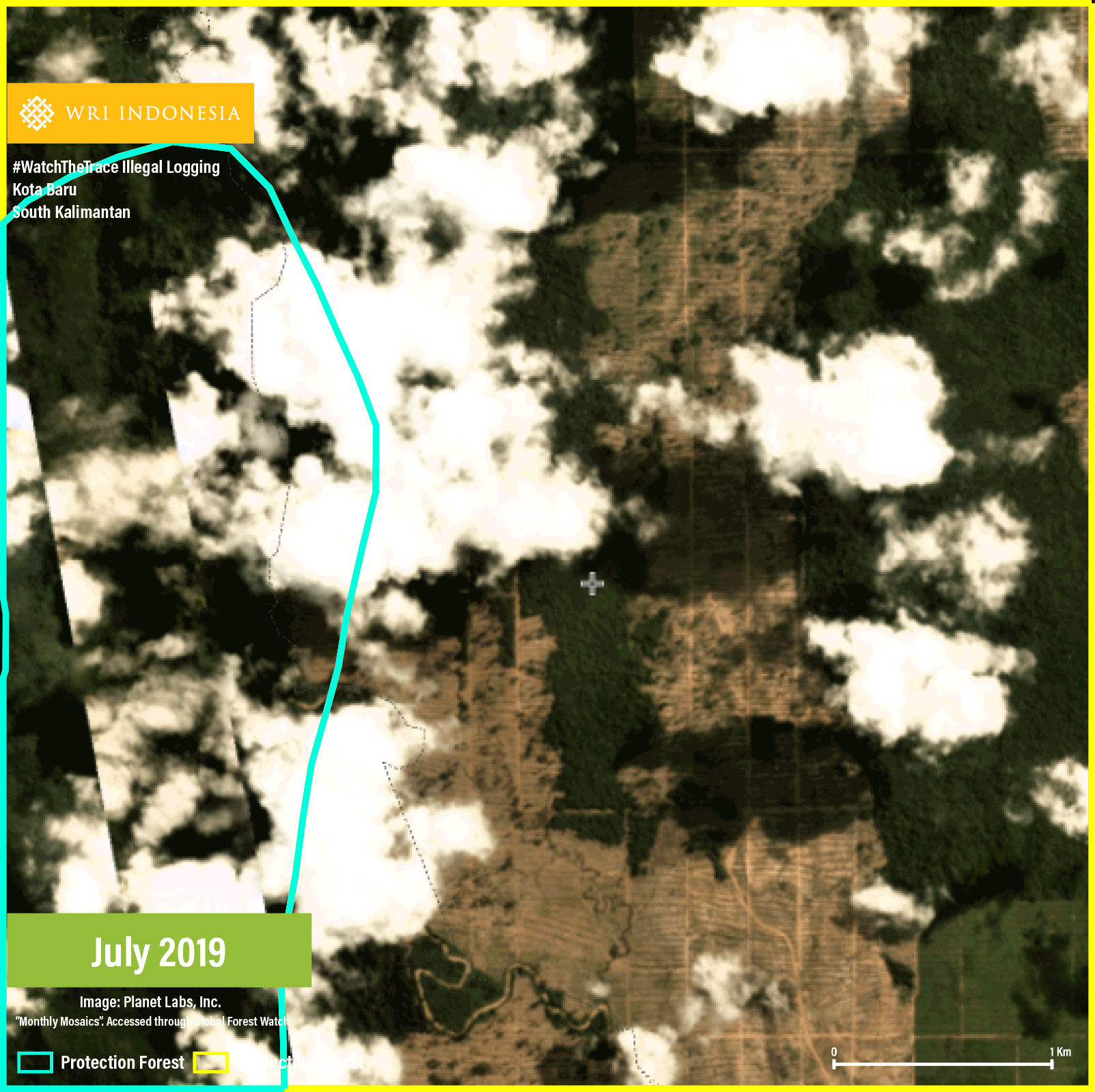
Cantung Kiri Hulu Village is featured in this edition of Places to Watch after previously mentioned in our sixth edition. This village is located in Kota Baru Regency, South Kalimantan. Logging activities have been spotted in an area of 205.38 ha, which belongs to a production forest area and directly adjacent to a protected forest area. Some parts of this indicated area are under the management of Unit VI KPHP Kusan, South Kalimantan.
If seen from the orderly logging pattern that forms large blocks that are connected to a road access, this land would typically be used as a plantation, although no planting activities had been spotted up to the end of the observation period.
#5 Indication of Illegal Logging at a 105.12-Ha area
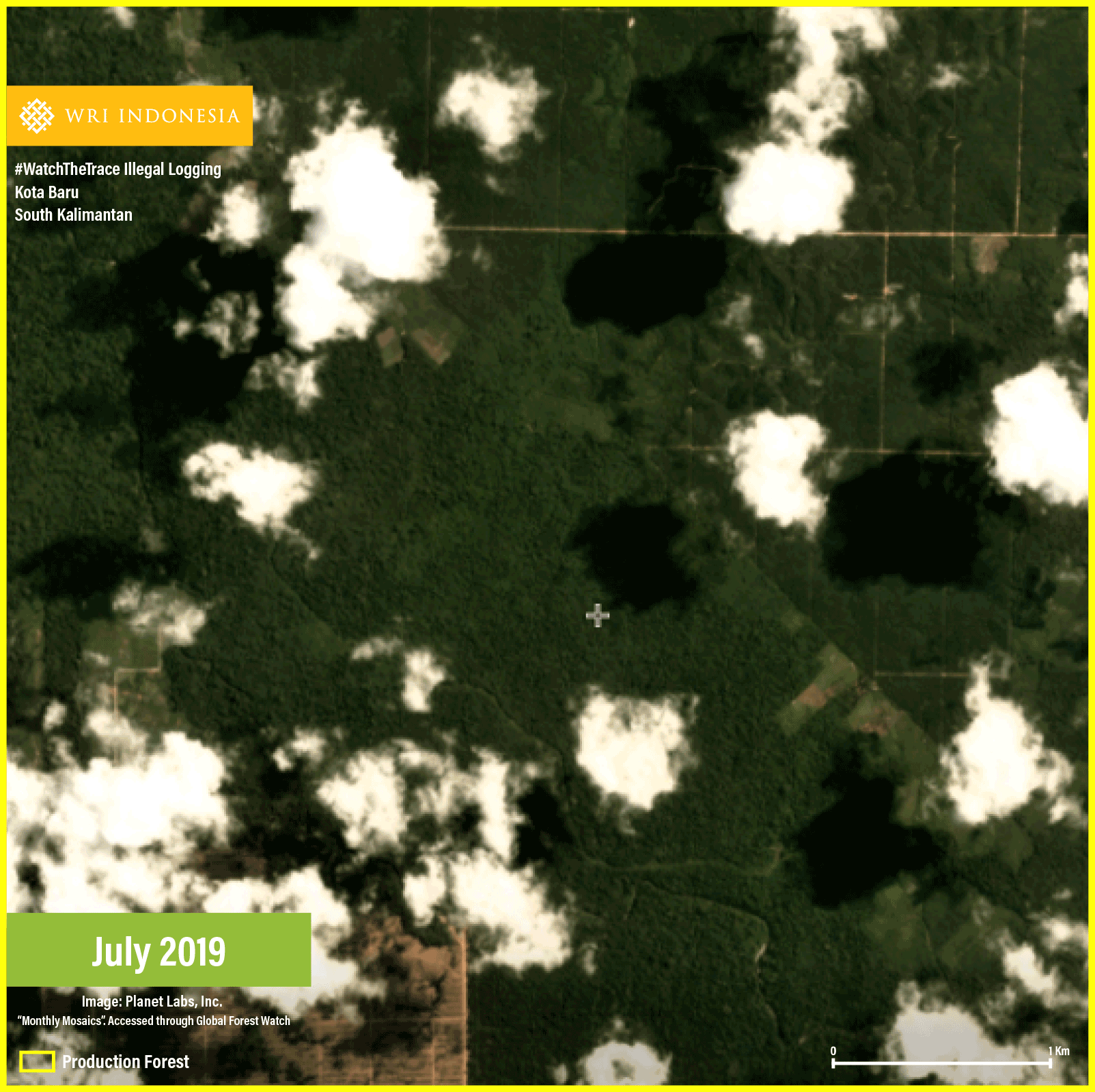
The fifth (#5) indicated area is located in Cantung Kiri Hulu Village, Hampang District, Kota Baru Regency, South Kalimantan, southwest of the indicated area #4. An indication of logging was spotted in an area of 105.12 ha that belongs to a production forest area. The logging activities were carried out in orderly large blocks connected to a road access and started between May and July 2019. The purpose of the land clearing remains unknown because there have been no visible planting activities on the cleared land.
The logging is linked to a cleared land in the southern part of the area that had been there since before the observation period. This indicated area #5 is adjacent to a concession area with Business Licenses of Utilization of Forest Products – Natural Forest (IUPHHK-HA) to the north east. A large area of palm oil plantation is spotted within the concession area.
Langkah Selanjutnya
These Top 5 Places to Watch are only indicated areas, which came as a result of observations using a number of tools, namely GLAD Alerts, Forest Area Status Map and Land Cover/Utilization Map. However, this analysis can be used in determining the areas where monitoring for illegal logging must be prioritized. Thus, subsequent steps that must soon be implemented are as follows.
1. Field Verification and Responsive Actions to Prevent Expansion of Illegal Logging in the Five Indicated Areas.
The Five Indicated Areas show that the logging activities are continuation/expansion of existing activities instead of a first-time logging, thus requiring a special attention to prevent further expansion of illegal loggings in the surrounding forest areas.
In addition, the five Indicated Areas show the urgency of mitigating the impacts of environmental damage, especially in areas that belong to protected forest areas and have contributed to increasing the risk of environmental disasters.
Therefore, the institutions authorized to protect the forest areas within the Five Indicated Areas, such as related forest management unit, the Director General of Law Enforcement of the Ministry of Environment and Forestry, the Provincial Forestry Office and the local police, must collaboratively conduct a field verification and take responsive actions to prevent further expansion of illegal logging and utilization of forest area as soon as possible.
Local community participation by providing field information can also speed up the verification process. If the field verification is not carried out immediately, illegal loggings will be increasingly massive and the negative impacts from environmental degradation are imminent. The wider the forest area that has been cleared and utilized for non-forestry activities, the more difficult the mitigation and recovery efforts.
The Fourth (#4) and Fifth (#5) Indicated Areas should become the focus of attention as they are located near to each other. In addition, the Indicated Area #4 has been featured in the Sixth Edition of Places to Watch and is adjacent to a protected forest area.
2. Following Field Verification, Responsive Actions Must Take Into Consideration Socio-Economic Aspects of the Local Communitiest.
Illegal logging activities across the Five Indicated Areas are all closely associated with small-scale economic activities. Therefore, following the field verification, responsive actions must take into consideration socio-economic aspects of the local communities. The response mechanism may incorporate a scheme of conflict resolution, recognition of social forestry potential, agrarian reformation and logical and fair law enforcement. It is also necessary to trace the suspects of the illegal logging up to the mastermind (intellectual actors) and beneficiaries of forest encroachment who take advantage of the activities.
Footnote:
The Places to Watch series have been presented based on Places to Watch methodology, with minor modifications, to identify areas with indications of illegal logging. Illegal logging is defined as logging activities in a forest area without any legal permission or logging activities with a legal permission but not in accordance with the provisions of Law No. 18 of 2013 concerning Prevention and Eradication of Forest Destruction. Due to data limitations, the Places to Watch series currently only represent the first scope.
Our methodology, which is based on WRI’s Places to Watch methodology, identifies areas with the highest detected GLAD alerts1. In particular, GLAD Alerts provides a weekly alert on tree cover loss. Modifications on our methodology, compared to the original Places to Watch methodology, are as follows:
We use a 5x5 km grid cell and not a 10x10 km grid as in WRI’s Places to Watch methodology, because the ability to capture individual cause to forest cover loss is better in a 5x5km grid cell. Further, we work on focus area images related to logging activities in forest areas without legal permission or with legal permission but not in accordance with the provisions, using layers below:
1. Forest cover data of primary and secondary forests from the Ministry of Environment and Forestry (KLHK). Forest cover data issued by KLHK is extracted, taking only primary and secondary forest cover and removing any industrial plantation forests data. We then overlap the GLAD alerts data with the forest cover data to identify biophysical clearing in forest cover areas, regardless of the legal status of the forest. Source: http://geoportal.menlhk.go.id/arcgis/rest/services/KLHK accessed in October 2018.
2. Forest areas have their own legal status as designated by the related government ministries. We retrieve their status to identify indications of illegal clearing within the forest areas. Source http://geoportal.menlhk.go.id/arcgis/rest/services/KLHK accessed in July 2019. Forest area is an area determined by the Government, namely the Ministry of Environment and Forestry, as forest, so it should not be used for non-forestry activities. This area is divided into three main functions, namely conservation (for the preservation and protection of plant and animal diversity and their ecosystems), protection (for the protection of life support systems such as water, disaster mitigation, etc.) and production (to produce forest products). Timber in the conservation and protected area basically should not be utilized, while in production forests, timber utilization is permitted if balanced with reforestation efforts. Meanwhile, the production forest area is further divided into three, namely limited production, fixed production and convertible production forest areas. These three types of production forest areas have different criteria and are tiered from the most limited scope of utilization to the most extensive. A convertible production forest area is a forest area that can be widely used, for example as the reserve area for non-forestry development activities, such as transmigration, settlement, agriculture, and plantation. Upon implementation, non-forestry development activities must undergo the procedure of forest area release.
3. Concession Permit. The collected data provides permits issued for various concessions, including for selective logging or Business Licenses of Utilization of Forest Products – Natural Forest (IUPHHK-HA), Business Licenses of Utilization of Forest Products – Industrial Plantation Forest (HTI), Business Licenses of Utilization of Forest Products – Smallholder Forests (HTR), village forest, Business Licenses of Utilization of Forest Products – Community Forest (HKm), social forestry, and land-use of forest area. Based on the regulations, land clearing activities inside the concession area are possible, so we employ this following layer to remove legal forest clearing. Source: http://geoportal.menlhk.go.id/arcgis/rest/services/KLHK accessed in July 2019.
Afterwards, we overlapped GLAD alerts with the focus areas, and the 5x5km cells. Scores for each cell grid were then calculated by referring to the number of GLAD alerts against the proportion of the focus area in each 5 km grid. We then selected the top 10 areas for further verification using high-resolution satellite images. Next, we used the Queen's Case Neighborhood method to detect the locations of the top 10 areas with cell grids that coincided diagonally and vertically and that generated large volumes of GLAD alerts. This method grouped adjacent 5x5km cells into one neighboring cell groups. All of these areas might then represent a similar cause to a specific forest cover loss incident (for example due to mining activities or clearing for plantations). After verified using high-resolution satellite images and identified as the cause of forest cover loss, we selected the top five areas to be displayed in this blog.
Afterwards, we conducted an initial verification through literature studies which aimed to provide additional information from secondary data about the development of illegal logging in the top five areas. The secondary data certainly cannot be interpreted as a final verification to the indicated area, but it can serve as an initial guide for further verification.
-
GLAD alerts from the University of Maryland via Global Forest Watch. The GLAD alerts provide weekly tree cover loss information in 30x30 meters pixel data, which is analyzed using Landsat satellite imagery. Each GLAD alert represents 30x30m pixels of 50 percent or more estimated forest loss within a 0.01 hectare area, as elaborated in this article. ↩︎